President of Russia Vladimir Putin: Good afternoon, friends,
I want to congratulate you on Russian Science Day and thank you for your hard work.
The Siberian Branch of the Russian Academy of Sciences, as you all know, is not only the largest regional branch but also a very advanced research facility that makes a significant contribution to many areas of science, the economy and knowledge, with results finding their practical implementation very fast.
I do not know how you see it and I would really like to hear from you about what is going on in Russian science. My understanding is that the merging of the agricultural, medical and general academy with respect to the Siberian Branch has produced some positive results.
Also, I would like to hear about the changes in the academy. Present here is Mr Kotyukov [Head of the Federal Agency for Scientific Organisations]. It is very important for me to hear about your relationship with the agency, via the academy office in Moscow. How does this relationship affect you? Which area should we focus on to increase productivity of Russian science and the Siberian Branch, in particular, in order to meet the country’s and the economy’s development needs?
Let me finish for now and pass the floor to Alexander Sergeyev. Mr Sergeyev, please.
President of the Russian Academy of Sciences Alexander Sergeyev: Thank you very much, Mr President.
Colleagues, I would also like to greet everyone here on such a wonderful day, Russian Science Day, and once again to recall that this also marks the day the Russian Academy of Sciences was founded, which is very symbolic, because the Russian Academy of Sciences was the foundation of Russian science, it served the glory of Russia. And as for the Siberian Branch, I think it is a fundamental regional branch that continues to carry the flag of Russian science.
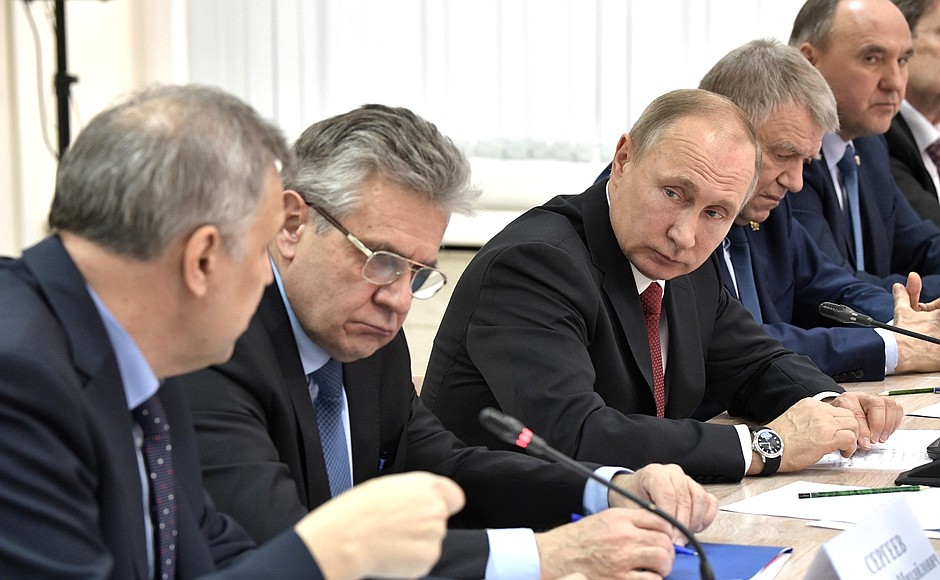
I think it is important that we are now going to discuss a serious question about the spatial element of the country’s scientific development. It is very important. In general, issues related to the spatial development of the country are critically important now. The Siberian Branch is the branch that could unite both the Central European part and the East in terms of science. It seems to me that we need to address the issue from this point of view with special emphasis on the fact that we should develop the Siberian Branch not just as one of the branches, but as a branch that can ensure the scientific cohesion of our country.
And, of course, I know that now my colleagues are preparing to voice their interesting proposals. I assume we’ll listen to them and then offer support.
Vladimir Putin: Of course.
Mr Parmon, please.
Chairman of the Siberian Branch of the Russian Academy of Sciences Valentin Parmon: Mr President,
First of all, on behalf of all Siberian scientists and specialists, I would like to congratulate you on Science Day and express my deep gratitude to you for spending this day here with us.
You have been to Novosibirsk many times, and we have met many times in other scientific centres of Siberia. You know perfectly well that the creation of the Siberian Branch of the Academy of Sciences was one of the most remarkable projects implemented in the mid-1950s to develop the vast Siberian macroregion.
The basis for the Siberian Branch’s effectiveness was established by its founder, Academician Lavrentyev, and is called “the Lavrentyev triangle.” Its three corners are science, education and production. This combination is exactly what allowed us to become so effective. You know that the Siberian Branch has faithfully executed all tasks assigned to it, and currently it is working on numerous projects of national and global importance; of course, there are new projects awaiting implementation.
Today the research capacity of the Siberian Branch is approximately one quarter of the total capacity of the Russian Academy of Sciences, and this capacity is characterised by high activity, ambition and readiness to solve tasks assigned by the state; it also has good coordination, which is very important.
This capacity is spread among nine large research centres and several cities. There are a lot of problems here we would like to discuss with you. They are primarily related to the fact that the Novosibirsk Research Centre is probably the largest research and education centre in the world with an unusually high concentration of expertise. However, it faces a lot of problems, because it was planned and established in the Soviet era. Its infrastructure and contents are not up to the demands of modern science.
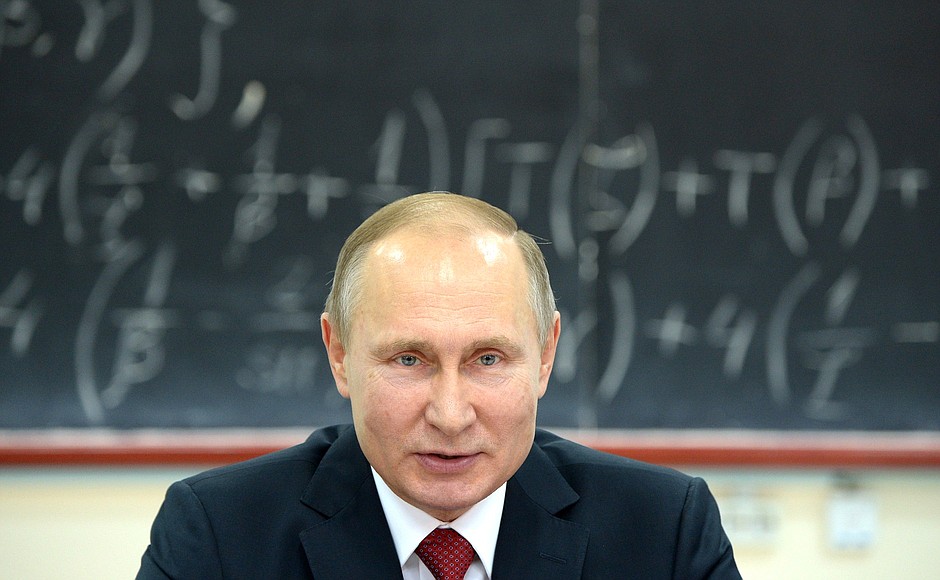
So primarily for the sake of the future, we would like to see a serious effort to develop the Novosibirsk Research Centre. We have agreed with the leadership of the Federal Agency for Scientific Organisations and the regional administration on how we should go about it. We would like to ask you for assistance by instructing the Government together with the Presidential Council for Science and Education to develop and implement a project for the comprehensive development of the Novosibirsk Research Centre.
We also believe it is necessary to create development plans for other research centres in the Siberian macroregion. As such, we ask you to give your consent and instruct the Presidential Plenipotentiary Envoy to Siberian Federal District to coordinate these activities.
Further, the fact that Russia has not implemented a single major research project in recent decades is a particularly critical issue for Russia, not just the Siberian Branch of the Academy of Sciences. Creating a new synchrotron radiation centre for shared use here in Novosibirsk could be one such project. This is a multidisciplinary centre. A variety of disciplines – biology, medicine, and physics – well, just about anyone – would be interested in having it here, not just the Siberian region, but also worldwide, including central Russia.
In this regard, if such a project were to become a reality, it would be an ambitious project. It could be the source of new competencies and, most importantly, the young people would regain their optimism and see that they can stay here to work and that the most ambitious projects could be implemented here. It would provide fertile ground to make sure our young people stay in Russian science.
In this regard, I would like you to issue an instruction for the Government to support this project, which will ensure the creation of a large research complex for shared use. It would be part of a major project that could be part of the research done in central Russia, but the important component would be here.
Training new personnel is important for us, Siberian researchers. The stability of the Siberian Branch was ensured by the fact that there is such a training system in place. It was implemented based on the close integration of science, research institutes and our leading universities. Here, too, things need to be adjusted.
In particular, with regard to the Novosibirsk Research Centre, an adjustment is needed due to the fact that Novosibirsk State University, which is the main forge for research personnel for Siberia, has a special system for training specialists, where active researchers from the institutes act as teachers and professors. This does not fit into the existing system, including funding. As head of the department, I am paid 1,500 rubles a month for doing administrative work at the department, although I do a lot of actual work. In a number of cases, my specialists receive 1,000 rubles a month to hold workshops.
In this regard, please instruct the Ministry of Science and Education to focus on financing training at universities such as Novosibirsk State University.
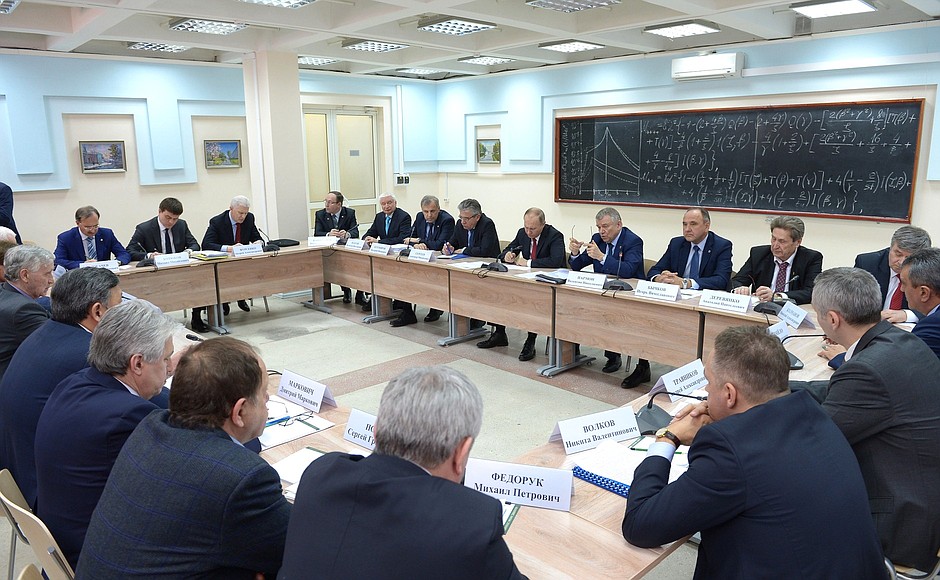
Finally, I would like to express hope that, with your help, the second and third phases of the construction of the university’s main building will be completed. It works fine, but there are no labs there. Physicists, chemists, and biologists, unfortunately, still have to make do without labs.
We believe that the Novosibirsk Research Centre and all the other research cities in Siberia can again attract, and are obligated to attract highly qualified personnel in education, science and high-tech. They will bring Russia’s vast territory together through this.
The power of Russia and Russian science will grow in Siberia.
Please consider our requests. Thank you for your attention.
Vladimir Putin: Allow me to ask you a couple of questions.
You said it is necessary to adopt a plan for the comprehensive development of the Siberian Research Centre.
Valentin Parmon: Yes.
Vladimir Putin: Toward the end you talked about the second stage of the construction of the Siberian Branch of the Academy of Sciences?
Valentin Parmon: No, I spoke about the second and third stages of the construction of the Novosibirsk State University’s main building. The first main building is already open, and it is wonderful.
It is an indispensable part of the Novosibirsk Research Centre.
Vladimir Putin: As part of this plan?
Valentin Parmon: Yes.
Vladimir Putin: That’s clear.
Now let’s turn to large projects and the synchrotron radiation centre for shared use. I will tell you right off that Mr Sergeyev will have to let me know whether this is current and expedient.
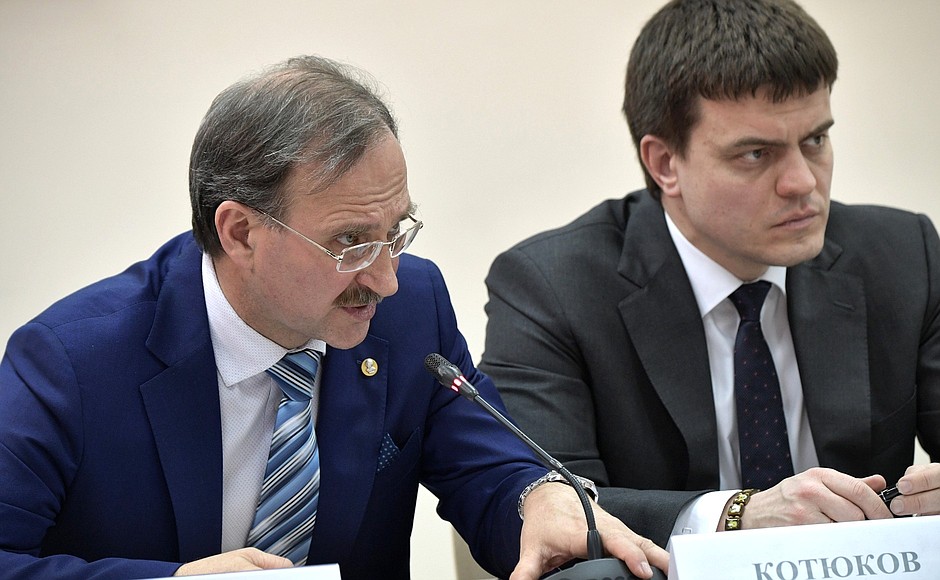
Valentin Parmon: The specialists here may also want to express their opinions.
Vladimir Putin: Yes, but since the specialists here elected the Academician the President of the Academy of Sciences, who is sitting on my right, we need some final decision from the Academy of Sciences, its Presidium and its President. Naturally, this will be done with your participation. In other words, we need to understand how this fits into the general picture of the priorities of Russian science. This is the first point.
The second point is the time period and costs – stages, general timeframe and costs.
Now let’s talk about personnel and the fact that the Academy of Sciences’ employees work at the university at some incomprehensible rates. Yes, of course, Mr Fursenko is here. I would like to ask you to draft the relevant instructions. We will deal with this. Ok?
Presidential Aide Andrei Fursenko: Yes.
Vladimir Putin: Mr Sergeyev, comment on this issue please.
Alexander Sergeyev: Colleagues, I wanted to express my support in the end, but let me express it now then. Overall, the synchrotron is a completely unique resource, not just from the fact that it can accelerate electrons to high energy, but because it is a source of unique radiation. This X-ray-range radiation has proven extremely valuable in recent decades for diagnostics in many applications.
The modern synchrotron is designed in a way that it is surrounded by dozens of workstations. These workstations are not only used by researchers who come here and test their new theories, but it is now a place of pilgrimage for top high-tech companies, IT specialists, and pharmacists, because the synchrotron radiation makes it possible to take the analysis of the structure of matter to the nanometre level.
So, this source of radiation is both a research unit for shared use, and generally speaking, a major commercial product, because it can be used to generate revenue to maintain it.
Question: What generation should this synchrotron be? Clearly, the new ones that are being built tend to be newer generations.
Vladimir Putin: Next generation. Otherwise, it makes no sense to build it.
Alexander Sergeyev: This is not an easy question, Mr President, because if we want it to be a 4+ or 5th generation, it will certainly be very expensive. High-generation synchrotrons are normally built to break new ground in research.
I believe we should approach this in a reasonable manner from the economic point of view. It should be a synchrotron not of the newest fourth or fifth generation, but it should be a tool that will primarily serve the interests of the large number of researchers in Siberia. I think probably, because of location, researchers from China will come here as well, correct?
Audience: Korea, Japan, China, India.
Alexander Sergeyev: It will also serve corporate interests, including the interests of our companies. I presume our colleagues will now go over the cost issues.
I think we should also discuss this with Mr Kovalchuk, because he is now leading the construction of the megascience class unit which is a synchrotron of a higher generation.
Actually, if we imagine the future of our country from the perspective of science, we must have not just one synchrotron, we must have at least three of them – in the central, European part of the country, in Siberia and, as a matter of fact, in the Far East. Synchrotrons are popping up around the world right now, and we must understand that people also think about the future of science and technology. What shall we start with? I think, with Novosibirsk.
Vladimir Putin: How about deadlines and costs? You kept on speaking but have not answered a single question of mine.
Director of the Budker Institute of Nuclear Physics Pavel Logachev: I want to say that we are actively engaged jointly with the Kurchatov Institute on the ISSI-4 project. It is one of six mega projects, it stands second in implementation priorities. The first priority list has NIKA, PIK and Ignitor followed by ISSI-4. However, the ISSI-4 is a flagship, large machine with a capacity of 6 GeV, parameters exceeding all limits.
And it is quite natural that in order to start such a large project, we must have proven technologies and national cooperation, as we have already seen today from a smaller example.
This project can really become a prototype and solution to the concrete task of creating a regional machine. The same bricks will be used to make ISSI-4. It will cut the costs of such projects, and we can also become a part of that large project. It means that it must simply be considered at the respective venues and in accordance with our existing structure.
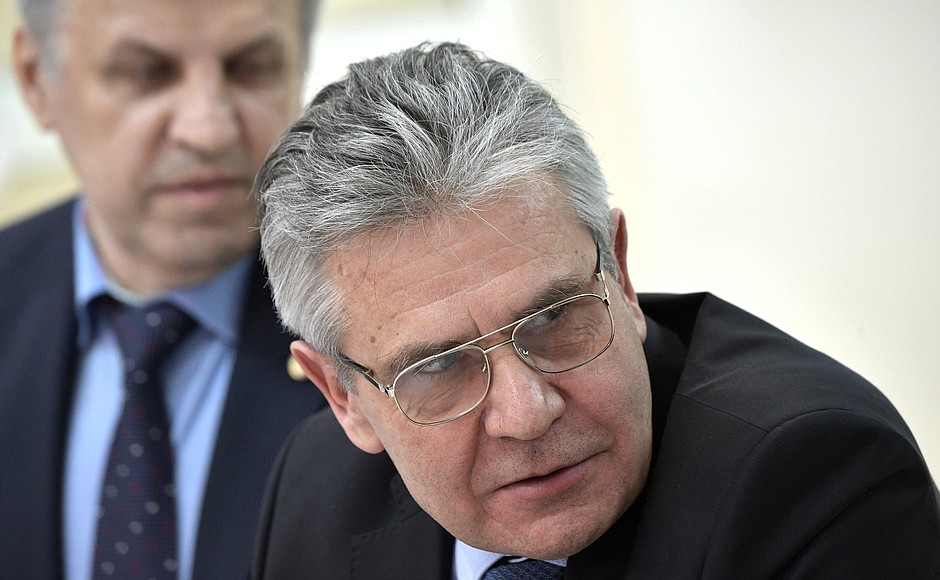
But of course, all our physics centres will undoubtedly participate in that work, absolutely all of them.
Speaking about the costs, it all depends on how much these workstations will have to be additionally equipped, as they make up the bulk of the cost. The synchrotron itself will cost, I think, around 20 billion rubles, maybe less. But the stations will exceed 20, if we make about 40 of them, and they are very complex.
Vladimir Putin: But can you give an estimate?
Pavel Logachev: About 40 billion with the stations. One half of it on the stations, the other half on the synchrotron.
Director of Boreskov Institute of Catalysis Valery Bukhtiyarov: I will try to add since I am director of the Institute of Catalysis, a chemical institute.
I can say that our institute is probably one of the most advanced users of such machines in the Siberian Branch. We actively work and get, that is to say win, time on synchrotrons in France, Germany, Switzerland, Britain. One of the stations is at the Kurchatov Institute which we operate together with the Kurchatov Institute, we invested quite a bit in its development. Basically, a station is around $1–1.5 million if it is not a fancy one. I think the first stage could include not the full 40 stations but around ten of them.
Let me underscore again what Mr Parmon spoke about – this is a multidisciplinary task. Which means the Institute of Nuclear Physics is the leader, it can make the source of synchrotron radiation itself whereas over ten institutes of the Siberian Branch can be responsible for creating the stations.
The Institute of Catalysis, I can guarantee, can make two to four of them. That is, at the first stage we would start making two stations which are badly needed. Because when we apply for time at such stations in ESRF (France), DESY (Germany), only one in ten applications is granted time. It means that if we achieve the same level, people will be coming here to us, including from Europe. And this means that there will be an exchange of ideas, exchange of views.
When we go there, we certainly tell them about fundamental research, however, we kind of illegally bring some samples for SIBUR, for Gazprom Neft. Because we don’t want them to get out in the open. You arrive and always have to explain what you are going to do during the week you have won. Time is given for free, and moreover, in some places they reimburse accommodation and travel expenses. But you must speak at a seminar and talk about what you are going to do, present your ideas, and it all becomes known, naturally. But to reiterate: we run some samples during the night-time there.
Pavel Logachev: I would put it this way: such a project is quite feasible within four years. Four years with the launch, maximum five years.
Let me give you an example. We got the LIU-20 linear induction accelerator in under three years, including the main production and preparation.
Valery Bukhtiyarov: In principle, even less with the stations. So, if we start at the same time, the first stations may be already operating by the launch of the synchrotron source.
Vladimir Putin: Here’s what I want to say first. From 1958, when the Siberian Branch of the Academy of Sciences was established, it developed at a very fast pace. Young researchers and research organisers with advanced, at that time, ideas came here. The state invested considerable resources in this project. I will not dwell on why they did so, you know this better than I. But creating this platform was the right thing to do. Of course, much has been accomplished since 1958, but I tend to agree with Mr Parmon: we need an impetus to take it to the next level.
Valentin Parmon: Preparations have been made for the second wave of development. We are fully prepared.
Vladimir Putin: The only thing lacking is a plan for comprehensive development. Let us draft it. As always, the question will arise about what activities should be included in the plan, and where the funding should come from. If we do nothing, nothing will happen. This is my first point. I believe this is the right thing to do now, especially since we are properly equipped to do so.
Now, with regard to major projects. We need them. They are good for our country. They unite and mobilise people, and they drive progress.
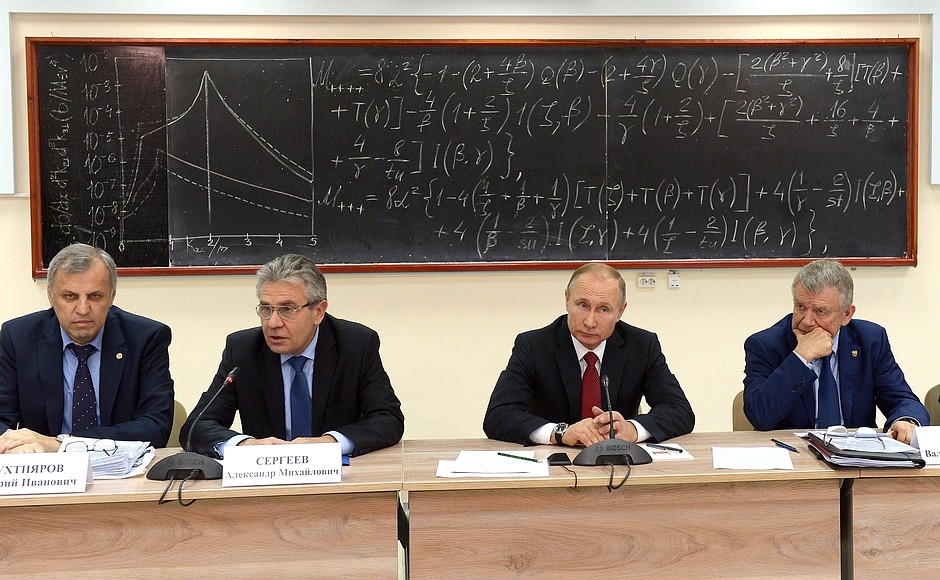
Of course, I am always pleased to say that we are taking part, for example, in creating high-energy electron installations in Hamburg, or Paris, or are doing something in Japan. This is very good and we have time there. However, in order for Mr Bukhtiyarov not to have to look for things like a thief in the night, we need to create things in our country as well. Plus, this will give us an additional competence. Mr Parmon was, of course, right when he said that young researchers would also be interested in it. This is absolutely correct.
The deadlines that you provided are quite foreseeable and clear, and the cost is also acceptable. This can be done. So, go ahead and come up with the proposals. I am not saying it will happen overnight, but delaying things is also a bad policy. Do it now, and we will try to adopt the corresponding decisions as soon as possible, so as to be able to move from talk to actual work on this project.
I have covered the personnel issues as well, I believe.
We need to finish the construction at the university, as well. This is a separate project, kind of routine work, but it also needs to be done. To do so, we will need the appropriate request, paperwork, and applications. All right? Agreed then.
Mr Choinzonov, please.
Director of the Cancer Research Institute of the Tomsk National Research Medical Centre of the Russian Academy of Sciences Yevgeny Choinzonov:
Mr President, colleagues,
Any projects that we discuss today, especially big and ambitious projects, should be carried out by creatively active and above all healthy people. The changed demographic situation, the fact that Russians live longer poses new challenges for the academic medical science. As you know, they have to contend with diseases common to the elderly. These include not only cardio-vascular and oncologic diseases, but also diseases of the locomotor system, eyesight, hearing and nervous and mental disorders. These are the challenges facing the academic medical science.
The population of Siberia and the Far East must have access to qualified, high-tech healthcare here without having to go to the central federal clinics. This would not only take some of the burden off the budget, but would make it possible to treat and deliver medical assistance to more people in Siberia and the Far East. With a population of 26 million in the region, this is an extremely important task facing the medical community.
The Tomsk National Medical Research Centre of the Russian Academy of Sciences is an example of a successful multidisciplinary clinic. We have united six of the Academy’s medical institutes within this centre. We have seen success in developing new technologies and treatment programmes.
We have similar centres in Irkutsk, Novosibirsk and Krasnoyarsk. We could use the technologies developed by our centre and create an integrated system of institutions that will deliver highly qualified assistance to our fellow citizens.
I believe there is only one problem, Mr President. Today the equipment at our clinics, unfortunately, is not up to the highest standards. If a programme of modernising multidisciplinary clinics is adopted at the federal level all the tasks the state sets before us with regard to maintaining the nation’s health could be successfully solved here at the regional level.
Thank you.
Valentin Parmon: Mr President, you asked what we think of the move to consolidate the three academies into one. The Siberian Branch believes that we only stand to gain from it, because medicine has merged with biology and the tasks it handles are also similar to those of the chemists while the agricultural sciences have been given an impetus by biologists, genetic engineering and so on. So, we believe that we have only benefited from this move.
Vladimir Putin: As for the programme to modernise multidisciplinary clinics, I believe, and the Government is of the same view, that one of the major areas in the near future is the development of healthcare in general and, of course, part of this healthcare development programme is providing equipment to the multidisciplinary clinics.
I cannot specify the amount and what exactly will be done right now because it requires calculations to be made, something that is being done now. But we will definitely be moving in this direction.
Please, go ahead.
Director of the Federal Research Centre Krasnoyarsk Scientific Centre Nikita Volkov: Nikita Volkov, directorof the Federal Research Centre Krasnoyarsk Scientific Centre of the Siberian Branch of the Russian Academy of Sciences.
I would like to touch on the question relating to the structuring of former academic institutes and existing institutes that are subordinate to the Federal Agency for Scientific Organisations, specifically, regional and federal research centres. This programme is being implemented now and quite a few centres have already been established in Russia. One of the first projects was the Krasnoyarsk Scientific Centre, which has consolidated nine academic institutions. Almost all of the academic institutions in the Krasnoyarsk Territory were made part of this Federal Research Centre.
We have been working for 18 months now. Generally, my assessment of the project is positive, despite some difficulties, which are inevitable, and shortcomings. I would like to take the opportunity – you have just been to Siberian Federal University in Krasnoyarsk – to invite you to visit the Federal Research Centre, which probably has the same status as a federal university. At least, it is not inferior. So, please, be our guest.
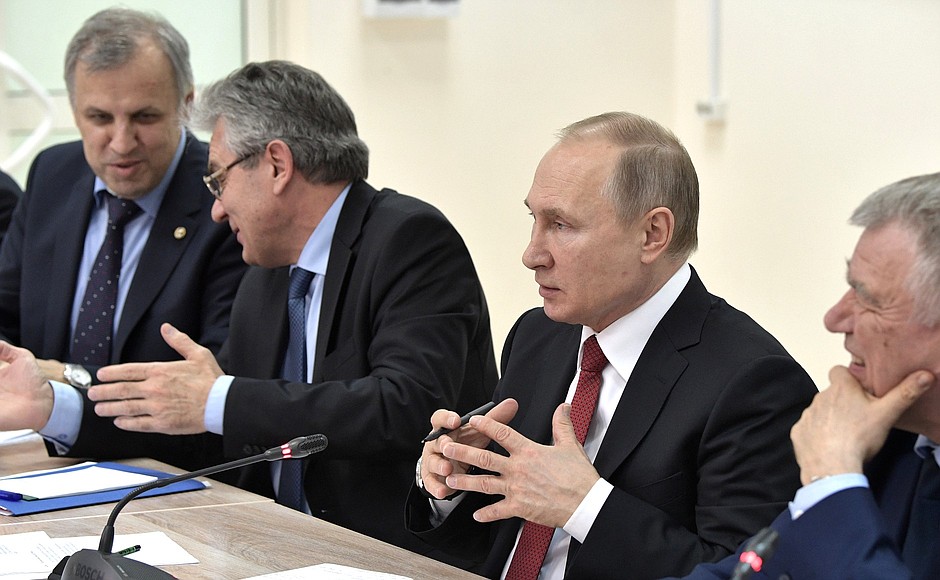
I have put together a little album, anyhow. If we look at Krasnoyarsk Territory and the huge area it covers, our centre sprawls from Norilsk to the southern edges of our Kranoyarsk Territory. In fact, I think ours is an infrastructure project, that is the way I see it. It means that we have brought the infrastructure together. This joining of infrastructure leads to the removal of many barriers – barriers to interaction between the institutes that used to be separate legal entities.
Firstly, these are economic barriers. Secondly, bureaucratic barriers, and, of course, legal barriers.
But the key is that we have managed to organise several large projects which are called “multidisciplinary projects” that encompass all the institutes, starting with physics and chemistry, and including agriculture, which also joined our federal research centre.
Let me speak briefly about one example. It is the so-called space technologies. It seems like Krasnoyarsk Territory has nothing to do with it. What do space technologies mean? We know that Krasnoyarsk is home to Information Satellite Systems. This is a company that manufactures over 70 percent of Russian satellites including the complete GLONASS fleet. This is the Radiosvyaz NPP, which in Soviet times was a top classified enterprise known as POB Number One. You know what a POB enterprise means. This is the entire surface segment of space communications; it is the regional centre of Earth’s remote probing. As far as I know, it is currently located in three Russian regions only. This is the reason why we had to make use of these advantages.
We are working well with them, successfully enough. This involves space material science; this involves communications, electronics, even biology. There is a very interesting project that was initiated by Sergei Korolyov back then – a closed life-support system for space, for people living in space. It is now applicable on Earth, too. I mean to say we propose making autonomous complexes for the Arctic based on those designs. If we look at our Territory, we will see that a large part of it is occupied by the Arctic, Arctic regions and wilderness. These are environmentally self-contained, close-loop energy systems where one can live with appropriate medical monitoring because the Institute for Medical Problems of the North has also joined our research centre.
With regard to Earth’s remote probing, we cannot do without it, as the territories are so huge. It involves monitoring the weather, forest cover and vegetation, snow pack, water resources and so on.
Of course, we do all that in contact with the Siberian Branch. That means we remain fully integrated in the Siberian Branch, in the Academy of Sciences. All these connections are in place, they have not vanished. We work with – and my colleagues are present here – the Institute of Nuclear Physics, the Institute of Semiconductors, the Institute of Catalysis and many others.
Taking into account the remark – Mr Kotyukov does not quite agree with me, he is a little skeptical – I would like to propose paying attention to regional centres. We speak a lot about Novosibirsk, the Novosibirsk Akademgorodok. It is indeed a unique situation, and a special comprehensive programme is needed. And such regional centres as the ones in Krasnoyarsk, Irkutsk and Yakutsk, are, let us put it this way, major employers. They can raise the region’s status, its competitiveness, its overall capacity, and what Mr Sergeyev and Mr Parmon spoke about – the connectedness of the territories. We cannot lose that territory, which has intellectual and economic potential, and the competitiveness of those regions.
I have the following suggestion: why don’t we try to draft a separate programme, similar to the one initiated by you on establishing federal universities, including Siberian Federal University?
Thank you.
Vladimir Putin: It is necessary to understand what exactly you mean.
Look, all the listed establishments of the Siberian Academy of Sciences have been united. You listed the ones that refer to your centre. Everything is already there. And it is all operating. What else do you need?
Nikolai Volkov: There is a lack of infrastructure because there are problems with inherited infrastructure, for example, the Institute of Agriculture. I by no means want to …
Vladimir Putin: It is about the specific development of particular segments.
Nikolai Volkov: Yes, exclusively. We have prepared proposals, we have them at hand. Mr Kotyukov knows very well about them.
Vladimir Putin: What can you say about that?
Director of the Federal Agency for Scientific Organisations Mikhail Kotyukov: Mr President, as a follow-up to what Mr Parmon said, the research infrastructure in many cases dates back to the middle of last century. And, respectively, the research devices that would allow for a significant transition to a new quality are insufficient not only in Novosibirsk but also in Tomsk, Krasnoyarsk, Omsk and Barnaul. This is the reason why the essence of the comprehensive programme we spoke about in the beginning does not only envision the development of Akademgorodok where we are now, but it is a little broader, involving the whole of the Siberian Branch.
Vladimir Putin: We have to give it more thought. But I think it is reasonable, on the basis of upgrading and developing the park – Mr Sergeyev during our recent conversation also raised this issue – to speak not just about procurement and distribution but rather about specialisation. In that case, budget funds would also be spent in a more reasonable way. We have to speak about the needs of the region and about the availability of research resources, and to specialise respective areas. And then the progress would be more widespread across the country. They would stop sending everything to Moscow or St Petersburg. This would be the right thing to do. We only have to make proposals and work it out.
Mikhail Kotyukov: This is the way our work is organised now. We agreed with Mr Sergeyev ahead of the meeting to look into all our plans within the implementation of the technological development strategy in exactly this perspective.
Vladimir Putin: All right. Do you have any proposals or suggestions?
Mikhail Kotyukov: Yes, we do.
Vladimir Putin: Fine.
Nikolai Volkov: Regarding the collective use centre, it has been implemented. This merger allowed for a more efficient use of the collective use centre since some issues of a legal, economic and bureaucratic nature always pop up. It is equipped pretty well, so to say. Thanks to the support of such programmes for regional research centre development, we also acquired the capability to upgrade these areas. It gave a boost to agricultural institutes, which practically had no resources. Now they can use this top-grade equipment. This is definitely a plus. I believe this trend should be continued.
Thank you.
Vladimir Putin: We will look into it again.
The floor is yours.
Director of the Matrosov Institute for System Dynamics and Control Theory Igor Bychkov: Mr President,
Currently throughout the world, as you stressed, including in Krasnoyarsk, environmental issues are among the top priorities.
I represent the Irkutsk research centre as head of research of the Irkutsk centre. But it turned out that since December 6 of last year I have been acting rector of Irkutsk State University, that is, research and education in one person.
Today very many environmental studies are indeed underway on Baikal, there is extensive research of the Lake Baikal ecosystem. Our scientists together with their colleagues from Novosibirsk, Tomsk, Chita and Ulan-Ude work on undoing the damage accumulated during the operation of the Baikal pulp-and-paper mill and other enterprises. There are tangible results in eliminating arsenic pollution in Svirsk and mercury pollution in Usolye-Sibirskoye. As of today, there are very many studies, and just last week an inter-agency commission on Baikal had a meeting in Irkutsk chaired by Minister of Natural Resources and Environment Sergei Donskoi, that focused on monitoring the environmental situation in Baikal.
In our view, and we have drafted this at our Irkutsk centre jointly with the Limnologics Institute, a new approach and new projects are needed. We ask as part of today’s meeting to focus on Lake Baikal monitoring based on new principles. Unfortunately, we can say that this monitoring largely remains a 19th or even 18th century type of monitoring. They used to set out in rowboats, now they do it in motor ships. They used to take samples from a depth of 200 metres, now we take them from 1,400 metres. They used to look at them through a microscope, now we use an electronic microscope. But the online system involving robotic systems, a system constantly collecting information seven days a week with the use of autonomous unmanned submersibles, is the project on the agenda today.
We are unable to explain many of the processes within the framework of the current monitoring. Late last year 150 seals were stranded on the beach. All the indicators we monitor are in line. Why did that happen?
We need such systems today, and one such project is being proposed today, including, apart from online monitoring, a digital technology age large data storage base, distant probing data, which has been spoken about, supercomputers. The environmental project with its centre in Irkutsk connected with the Baikal area is ready, and we would like you to consider the possibility of its implementation. The costs according to current estimates amount to 3.5 billion rubles, three years of work to reach the first stage.
The second Baikal project. You have visited Baikal several times and the museum of the Irkutsk research centre. There are preliminary project designs that were presented to the inter-government commission on establishing a large centre for promoting an environmental outlook. It was presented, among others, to that very inter-agency commission. Its funding is expected to comprise two stages – the detail design is ready – which amounts to 6 billion rubles. This is museum level. First, this is the only lake museum in Russia, and it will be the third museum of this kind in the world. Its quality and so on are on a par with the Far Eastern Oceanarium. These are the plans. And we are eager to have this project among those being implemented today.
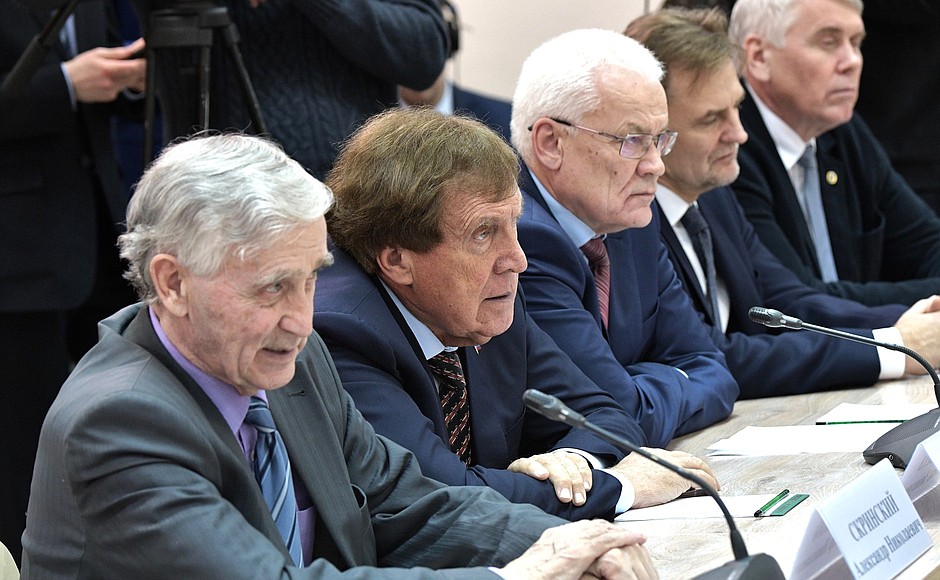
It so happens that the Baikal nature area is also becoming a magnet, including for studies related to space and around space. You are aware that the Institute of Solar and Earth Physics initiated the establishment of the National Geophysical Centre of the Russian Academy of Sciences. The first stage has been accomplished. Now we are waiting for the second stage to be done.
Two more projects are underway at Irkutsk State University – the Taiga project and the neutrino telescope project. It is a kind of an asymmetrical response to the existing hadron collider in this respect. We would like to support further work in that direction.
And Mr Parmon mentioned the Lavrentyev triangle – science-education-industry. Science, education, and personnel training are closely related to Irkutsk State University, which turns 100 years old this year. We would like you to instruct the Government to issue a respective directive on celebrating the centenary. I invite you on behalf of all the faculty, staff and almost 15,000 students. We would like to see you as a guest of honour in Irkutsk on October 27. The current issues pertaining to the university could be resolved within that directive. We submitted our proposals in this regard.
The following are not large-scale projects, but rather real-life requests. One is related to what we have long been discussing –reinstating the academic research doctorate programme. It is currently the third education stage. We have been speaking about it for a long time but it never materialises.
And one more, maybe even less significant, issue. I am sitting next to Academician Derevyanko, winner of the State Prize in Science and Technology and a renowned archaeologist. And we do not have archaeology training at higher educational establishments. One might wonder…
Vladimir Putin: I think there are departments of archaeology.
Igor Bychkov: Departments cannot exist once there is no education profile. There are master’s and doctorate programmes, but there is no education profile. I do not see any limitations for this to be done. I spoke with our experts in archaeology, and they also voiced the same request. If possible, Ministry of Education, please take note.
Thank you very much.
Vladimir Putin: I do not see any limitations here either. I thought that if universities have departments, they have respective programmes for training specialists.
Igor Bychkov: There is a list of specialities.
Vladimir Putin: I understood one thing – this is red tape, which probably impedes the development of the discipline. Let us see to it.
As to your recent proposals, we have to prioritise. I just do not know. Mr Fursenko, do you have these proposals from Irkutsk?
Andrei Fursenko: I specifically asked Mr Kotyukov for them.
Mikhail Kotyukov: We have not seen everything regarding the university, of course. With regard to developing infrastructure in one way or another, we have designs for that.
Vladimir Putin: Mr Bychkov, I believe you should prepare it all, put it on paper and submit it. I am not saying we will do everything right way, but it is obvious that some matters deserve special attention, For example, Baikal monitoring and some other things. We have to select the priorities and consider the schedule and the pace.
Igor Bychkov: Thank you very much. We will do it by all means.
Vladimir Putin: Thank you.
Valentin Parmon: Mr Medvedev issued instructions regarding the museum, but it is not clear how they will be implemented.
Vladimir Putin: If it is not in the budget, it means it will not be implemented in this cycle.
Valentin Parmon: So it will never be implemented if it is not in the budget?
Vladimir Putin: Of course not. How would it be implemented if no funds are allocated? We have to look into it. Let us come back to it later and see.
Valentin Parmon: All right.
Vladimir Putin: Everything you said needs to be prioritised.
Valentin Parmon: I will certainly systematise everything and report to you.
Vladimir Putin: Please do.
Alexander Sergeyev: Mr President, I would like to specially underscore this Baikal monitoring project because it is synergic with another issue we are discussing – the provision of instruments for our research.
We can conduct modern monitoring not only by using high-precision equipment purchased abroad. We have in our country equipment that can be used. And it should be definitely ordered from our manufacturers.
Vladimir Putin: Of course.
Alexander Sergeyev: This is very important. It is at the intersection of the two issues we spoke about.
Vladimir Putin: Please, go ahead. I need documents. We will not solve the issue by just speaking about it, right? Meanwhile, I agree with you, this is definitely important.
Igor Bychkov: It is just that any road starts with the first step. We have taken the first step. Thank you very much.
Vladimir Putin: The seals beaching is surely a problem. But we know that whales also get stranded on the beach and still no one can say why.
Igor Bychkov: I am not saying it is a big problem. The point is that they now total around 100,000.
Vladimir Putin: No, I am not saying it does not matter.
Igor Bychkov: But it should be actually understood via the monitoring.
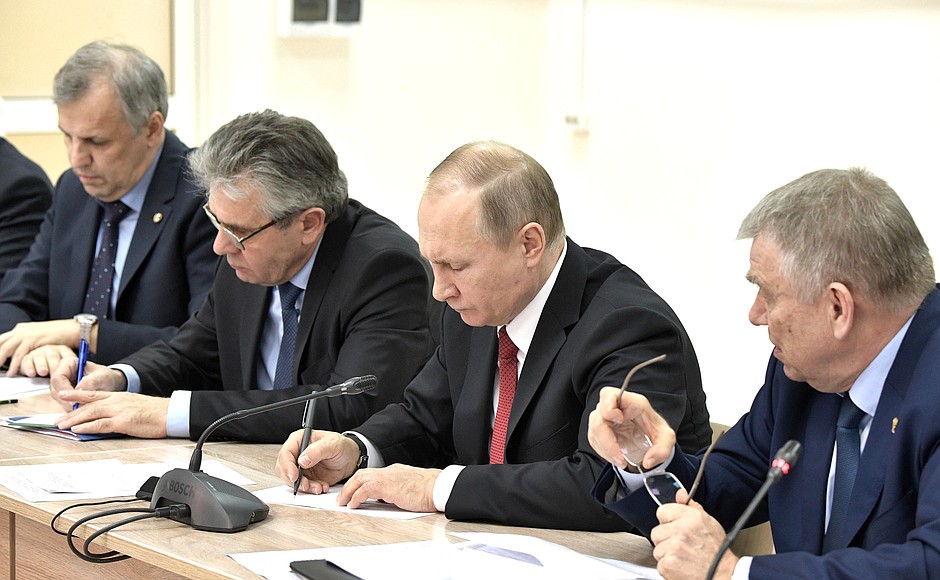
Vladimir Putin: I agree.
Mr Travnikov, you have the floor.
Acting Governor of Novosibirsk Region Andrei Travnikov: Mr President,
I would like to add to the proposals made by the scientists and officials, and say why this large project on developing regional centres should start here in Novosibirsk.
We are now at a large venue that focuses on science and education. But it is not the only place where a powerful “implementation belt” has been created in the past three decades: three technology parks, hundreds of innovative enterprises, and dozens of thousands of specialists, in other words, the Lavrentyev triangle is getting stronger here, gaining power. The Academy’s institutes and the Vektor federal research centre are historically located in different municipalities – Akademgorodok, Krasnoobsk, the science city of Koltsovo, and a promising site in the city of Berdsk. It is crucial now to start creating a new management system, comprehensive development of this unique territory, the comprehensive plans Mr Parmon spoke about.
Item 25 in the plan for implementing Russia’s science and technological development strategy stipulates designing standard development models for territories with a high concentration of research, developments and innovative infrastructure.
Novosibirsk Region is ready to become a pilot region for testing the standard model of the effective development of territories. To design a standard model, at least seven organisations of different agencies and levels have to participate, and funding must be procured from different sources – from federal, regional and municipal budgets and from non-budgetary sources. This is why I believe that a federal-level coordinating body is needed to design such a model.
Such conditions are already in place in Novosibirsk Region. An inter-agency group on the re-industrialisation of Novosibirsk Region headed by Deputy Prime Minister Arkady Dvorkovich is actively working in our region. We think that we have all the conditions to start the work head-on, and a tentative agreement has been made with Mr Dvorkovich.
I suggest that a standard model designed in such a way, a development plan based on the example of the Novosibirsk research centre, should be presented at the following meetings of the Presidential Council on Science and Education to make a decision on its implementation and replication in other regions with a high concentration of scientific and innovative potential.
We are ready to start immediately upon getting your instructions.
Vladimir Putin: Fine. Are we wrapping up? We will also have a Council on Science. I think all of you will be present, won’t you? So we will continue this work, this discussion, in a broader format
I would like you to put everything on paper, the documents we agreed on, and pass it over to Mr Fursenko. Mr Kotyukov also has something. It will all finally surface with him. We will work it out, and we will definitely move forward. I am not ready to say exactly on which issues, but on some of those that we discussed here and Mr Parmon spoke about. We will be enhancing the Siberian Branch of the Academy of Sciences.
I agree with Mr Parmon that a new impetus is needed. We have all the capabilities for that, and there is a need for it. Let us work on it.
Thank you.
